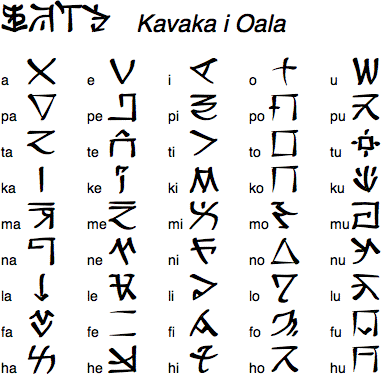The Kavaka o Fuvupo (literally the "Elders' Script") was invented by David Peterson and is used to write the Kamakawi language. It is a complex script which comprises a syllabary plus several subsystems involving pictograms, logograms, ideograms and other mixed glyphs.
The full writing system developed over the course of several centuries, with the syllabary being the last step in the process. The script itself takes the iku (a word meaning "character" or "glyph") as its basic unit. All iku take up the same amount of physical space, but a given iku may stand for a syllable, a whole word, part of a word, or simply an idea. Altogether, there are almost 600 iku. Sentences are written either from top to bottom (in formal texts), or from left to right, with no spaces between iku.
The Kavaka i Oala (literally the Spoken Script) is used to spell out borrowed words, but is also used for many native words. In addition, syllabic iku are often used in conjunction with other iku to create phonosemantic compounds.

In addition to syllabic iku, there are six main iku types used to encode the bulk of Kamakawi's vocabulary.
These are pictographs that are intended to depict the word they encode.

These iku comprise one or more syllabic glyphs, resulting in an iku whose pronunciation can often be guessed from its parts.

A kind of combination of the previous two, iku'ui usually involve a superimposed iku which adds phonological or semantic information to a base iku.

Iku'ume are slightly modified variants of other iku (often a stroke is simply added to one iku to produce a related iku).

Formerly, the Kamkawi script had a series of determinatives. Ikuleyaka are iku which retain some of the old determinatives. (The examples below all contain the negative line determinative.)

Finally, ikunima'u comprise iku that don't fit neatly into one of the categories above.

The Kamakawi have a base 10 counting system which is represented graphically by the iku below.

There are four main punctuation marks in Kavaka o Fuvupo which are used to demarcate sentences, to set off emphasized material, to surround questions, and to surround quotations. Those four marks are shown below in the order listed above.
![]()

Au emimu uila emi takemi u iema poe takoiki oi pou ikopuku. Au aemu omoko oi foyoko ti upea ae ha'ala'i i ikaika tie takeolaka ea.
All human beings are born free and equal in dignity and rights. They are endowed
with reason and conscience and should act towards one another in a spirit of brotherhood.
(Article 1 of the Universal Declaration of Human Rights)
More information about Kavaka o Fuvupo
http://dedalvs.com/kamakawi/orthography.html
More information about the Kamakawi language
http://dedalvs.com/kamakawi/
Kamakawi Word of the Day (featuring Kavaka o Fuvupo)
http://dedalvs.com/kamakawi/wotd/
If you have questions about this alphabet, you can contact David J. Peterson at dedalvs@gmail.com
Constructed scripts for: Ainu | Arabic | Chinese languages | Dutch | English | Hawaiian | Hungarian | Japanese | Korean | Lingala | Malay & Indonesian | Persian | Tagalog / Filipino | Russian | Sanskrit | Spanish | Taino | Turkish | Vietnamese | Welsh | Other natural languages | Colour-based scripts | Tactile scripts | Phonetic/universal scripts | Constructed scripts for constructed languages | Adaptations of existing alphabets | Fictional alphabets | Magical alphabets | A-Z index | How to submit a constructed script
[top]
You can support this site by Buying Me A Coffee, and if you like what you see on this page, you can use the buttons below to share it with people you know.

If you like this site and find it useful, you can support it by making a donation via PayPal or Patreon, or by contributing in other ways. Omniglot is how I make my living.
Note: all links on this site to Amazon.com, Amazon.co.uk
and Amazon.fr
are affiliate links. This means I earn a commission if you click on any of them and buy something. So by clicking on these links you can help to support this site.
[top]